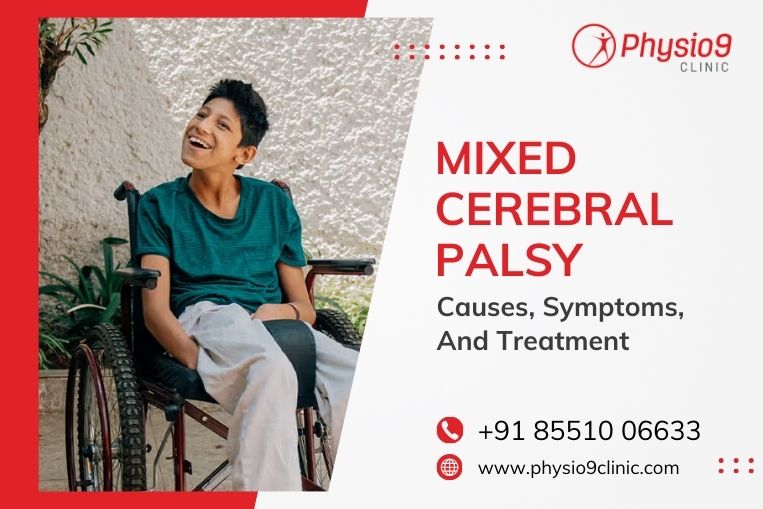When your child or loved one is diagnosed with cerebral palsy, you expect to hear one specific type—spastic, athetoid, or ataxic. But when the doctor adds the word “mixed” in front of it, the confusion level suddenly shoots up like an explanation of Inception. What does that even mean? And how is it different from the others?
Let’s break it down simply, with all the clarity that you truly need.
So, What Is Mixed Cerebral Palsy?
Mixed cerebral palsy means the person shows symptoms from more than one type of cerebral palsy.
Think of it as a combination meal—you don’t just get one thing, you get a bit of this and a bit of that. The most common mix is spastic and athetoid types, but other combinations can also occur.
The condition affects muscle tone, movement, and motor skills, making everyday tasks more challenging, but not impossible. The challenges may vary in intensity, and every case looks different. No copy-paste symptoms here.
What Causes It?
Mixed cerebral palsy usually occurs due to brain damage before, during, or shortly after birth. The causes are similar to other types of cerebral palsy, including:
- Lack of oxygen during birth
- Premature birth
- Infections during pregnancy
- Brain injury in early life
- Genetic or developmental disorders (though less common)
Basically, if something disrupts brain development, it can increase the chances.
Recognizing the Symptoms
Since it’s a mix, symptoms also show up from multiple types. You might notice:
- Stiff or tight muscles (spastic symptoms)
- Uncontrolled movements (athetoid traits)
- Poor balance or coordination (ataxic features)
- Difficulty in walking, speaking, or even using hands
- Muscle tone that switches between stiff and floppy
Some kids may struggle more with speech; some might trip often; some may need help holding a spoon without turning it into a mini juggling act.
Early signs can start showing before the age of 2, and as the child grows, the signs may become more noticeable, especially when developmental milestones are delayed.
Getting the Right Diagnosis
Let’s be real—no one wants to Google symptoms endlessly and lose sleep. The best way to get clarity is through a full assessment by a pediatric neurologist. Tests like MRI scans, muscle tone evaluations, and developmental tracking help confirm the type and extent.
It’s not about labeling the child. It’s about understanding their needs better.
Can Mixed Cerebral Palsy Be Treated?
Cerebral palsy doesn’t have a cure (not yet, anyway), but the right treatment plan can make a massive difference in quality of life. Managing mixed cerebral palsy means customizing therapy to match the unique combination of symptoms.
Common Treatment Approaches:
- Physiotherapy: Builds strength, balance, and mobility. If you're looking for support, a skilled physiotherapist in Pune can help create structured routines that improve day-to-day functioning.
- Occupational Therapy: Teaches everyday skills like dressing, holding objects, or using adaptive tools.
- Speech Therapy: Helpful for kids or adults who struggle with speech or swallowing.
- Medications: For managing stiffness, spasms, or unwanted movements.
- Orthopedic support: Braces, walkers, or sometimes surgery to assist in mobility.
Support is everything here. And no, the goal isn’t to “fix” anyone—it’s to help them thrive in their own unique way.
Living With Mixed Cerebral Palsy
Let’s not sugarcoat it—it’s not always easy. But with the right mix of therapies, care, and that unbeatable Indian-style family support system, life can be just as joyful and fulfilling. Whether it's learning to hold a brush, going to school, or playing carrom, every step forward counts.
There’s a quote that sums it up well:
“Disability is not the opposite of ability—it’s a different way of navigating the world.”
So, patience, therapy, and a bit of desi jugaad here and there—these go a long way.
All Mixed Up? Not Anymore
Mixed cerebral palsy may sound complicated, but understanding it doesn’t have to be. It’s a condition that brings a blend of motor challenges, but also a wide scope for support and progress. From causes that trace back to early brain development to therapies that help individuals grow, every piece plays its role.
So whether you’re a parent trying to figure things out, a teacher hoping to make the classroom more inclusive, or a physiotherapist in Pune helping someone regain control over a simple hand movement, your role matters. Because with the right awareness and care, every step becomes a milestone.
Want help navigating the next step? Start with understanding. The rest will follow.







